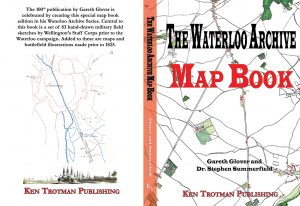
From Ken Trotman Publishing
220 pages of full colour maps and images.
To celebrate the 100th publication by Gareth Glover, it was decided to create this special atlas edition in his Waterloo Archive Series. The set of 83 hand-drawn military field sketches (maps) produced by various members of Wellington’s Staff Corps prior to the Waterloo campaign that are now bound in a folder held by the National Army Museum, caused great excitement among fellow lovers of maps. Both Richard Brown the owner of Ken Trotman Publishing and Dr Stephen Summerfield who has published profusely on the Napoleonic period insisted that these Staff Corps maps should be reproduced in the larger A4 format and beautifully enhanced by being expertly colourised by my co-author.
It was decided to expand the range of maps included to embrace any maps of the area of the Waterloo campaign produced prior to 1825. These maps are listed by their modern equivalent spellings to aid identification. This includes the relevant images from the monumental mapping of the Spanish Netherlands (Belgium) by Count Joseph Ferraris between 1770 and 1778 that formed the basis of the smaller scale, less detailed, Louis Capitaine maps of Belgium of 1797. These were used by Napoleon and Blücher and were the basis of Wellington’s maps and presumably many other senior officers during the campaign.
Also included is the earliest published version of the Willem Craan map of September 1816, which was the only accurate survey of the battlefield mapped before the Lion Mound altered part of the Allied ridge. It is also further enhanced by a number of contemporary maps showing the disposition of the troops at Waterloo, all produced within only a few years of the battle. We could not ignore the rest of the campaign and we have included a number of maps showing the entire area of the five battles of Charleroi, Ligny, Quatre Bras, Wavre and Waterloo and early maps of the battles of Ligny, Quatre Bras and Wavre, many of them being Dutch and German maps rarely seen in the United Kingdom. We have also included a number of contemporary maps of France, Paris, Mons, and Valenciennes from the collection held by Lieutenant General Sir Henry Clinton who commanded the Second
Division at the time of the campaign, giving further evidence of the quality of maps available to the senior staff of all the adversaries at the time.
But we have not stopped there! We decided that we must also include a number of the early views drawn of the battlefields, again before the battlefield was altered.
• Thomas Stoney remarkably visited the battlefields of Quatre Bras and Waterloo within days of the battle
of Waterloo and even sketched the unburied corpses, stripped of uniforms, awaiting burial on the
battlefields, giving us a very raw and immediate view of these battlefields directly after the battles.
• Denis Dighton, Military Artist to the Prince Regent also visited the battlefield of Waterloo within a week
of the battle and his early sketches of the fields, showing the local peasantry burying the dead and the
draughtsman like sketches of some of the main buildings involved in the fighting record exactly how they
looked very soon after the battle, whereas his later paintings based on these sketches (not reproduced in
this publication) show a less stringent rigidity to historical accuracy.
• The drawings of James Rouse, published originally in 1817 within William Mudford’s Historical Account of the Campaign in the Netherlands are also included although there are reasons to doubt their historical veracity, as Rouse was certainly not there earlier enough to see troops still on the battlefield or the burial/burning of corpses as portrayed; and there is some further doubt on the precise accuracy of a number of his depictions of the buildings, many being more atmospheric and an expression of their general look rather than the truly detailed versions produced by Dighton and therefore should not be relied upon for specific details.
The march to Paris has also not been ignored with a superb set of drawings made by Carmichael Smyth of the sieges carried out by the British and Prussian forces.
A number of other contemporary scenes of the battlefield round off this beautiful collection, which it is hoped that every Waterloo enthusiast will want to own and pore over for many hours. If successful, we already have a very ambitious multi-volume version of this planned to cover the Peninsular in the future.
